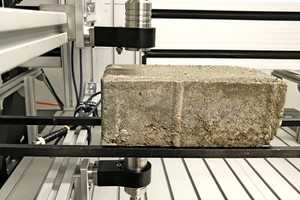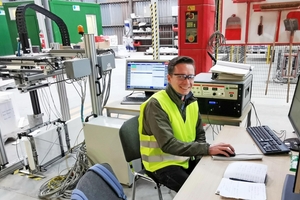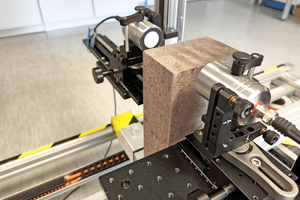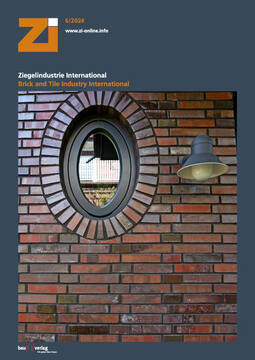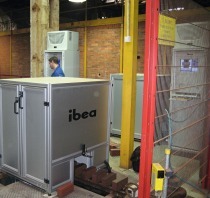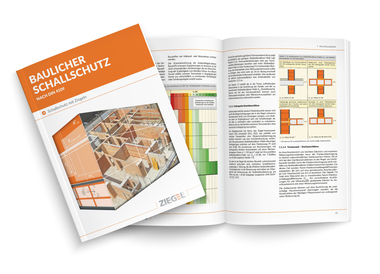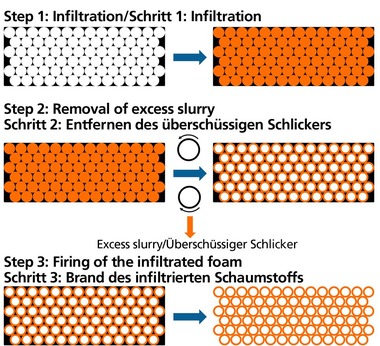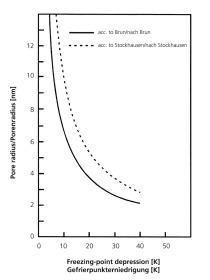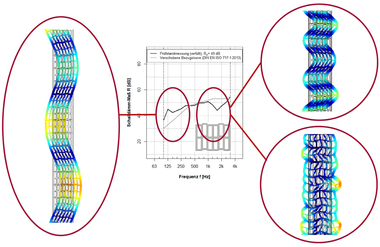When the scanner comes to the test specimen - New aircoupled ultrasonic testing methods for the building materials and ceramics industry
Continuous non-destructive quality testing during the ongoing production process is a real challenge for the ceramics industry, brick manufacturers and building material producers, as well as for other sectors. The FZ-U Ultrasound Research Centre is therefore developing non-contact testing solutions for materials and products that are difficult to inspect.
The scientists from Halle (Saale) rely on air-coupled processes that are designed for the first time ever for the respective application or are modified according to the user‘s specifications. This means that even particularly „unruly“ mass products such as ceramics, bricks, concrete parts as well as products made of plastic, composite materials, leather and even precious metals can be precisely inspected for defects and impurities. Always in our centre of attention: the compatibility of the new solution and the operating environment. Before the user makes far-reaching investment decisions, the industrial researchers usually analyse the general feasibility of the project, including the necessary prerequisites and foreseeable costs, thus minimising the economic risks with limited effort.
With its innovative approaches, the institute enables test procedures that were previously impossible or only of limited practical use. For example, ceramics can only be tested selectively using conventional ultrasound, and then only at great expense, as classic coupling agents such as water are unsuitable for this material. With air-coupled ultrasound, on the other hand, even larger areas can be scanned quickly and completely. Defects and flaws are precisely visualised in the resulting 2D colour image. Products can also be inspected before sintering. Inferior green bodies do not even end up in the furnace; energy savings of up to ten per cent are possible.
In most cases, tests are initially carried out on a sample basis in the institute‘s laboratory. If the size or weight of the test specimen - such as large components, heavy precious metal blocks or even entire GRP boats (glass-reinforced plastic) - does not allow this, a service unique in Europe comes into play: the FZ-U experts load their scanning technology into a van and carry out the feasibility and object tests directly in the customer‘s industrial environment.
Recently, the FZ-U presented a self-developed method for measuring sound velocity values in ceramics: For the first time ever, it is now possible to make reliable statements with concrete numerical values as to whether the density and homogeneity values of the material are qualitatively within the range of requirements.
There are also advantages for the production of cement or bricks: If it goes unnoticed when a kiln’s ceramic cladding is not sufficiently dense, this impairs its insulating effect and therefore the product quality. The thermal load of faulty insulating bricks leads more quickly to defects, maintenance expenditure and an increased risk of failure. Even the service life of wearing parts such as ceramic push plates for transport through the kiln can now be significantly extended thanks to practicable control methods.
Leading international brick manufacturer Wienerberger AG, with over 200 plants in 28 countries, also relies on the expertise of the Halle-based company: thanks to the support of the FZ-U, including on-site measurements with a mobile testing facility, the company says it has succeeded in improving and further developing the quality control of innovative kiln technologies. According to a company spokesperson, the „extremely competent team led by Managing Director Ralf Steinhausen“ deserves special thanks for this.
Air-coupled ultrasonic testing methods are easy to integrate into the industrial environment thanks to their radiation-free and non-contact mode of operation and enable high testing speeds even during assembly line transport. Instead of just random samples, this tends to enable continuous zero-defect inspection.
At the only industry-related research institute in Europe specialising in airborne ultrasound, all elements of the technological chain can be found under one roof. If required, customised software or hardware adapted to a specific project is provided by experienced industrial partners such as the international airborne ultrasound technology leader Sonotec.

